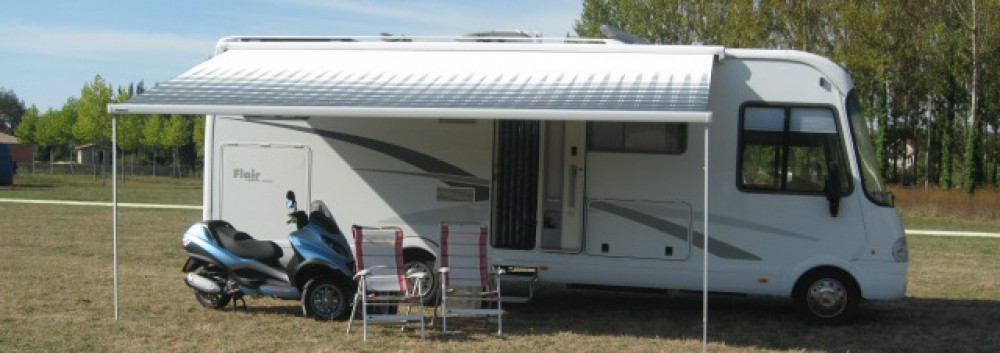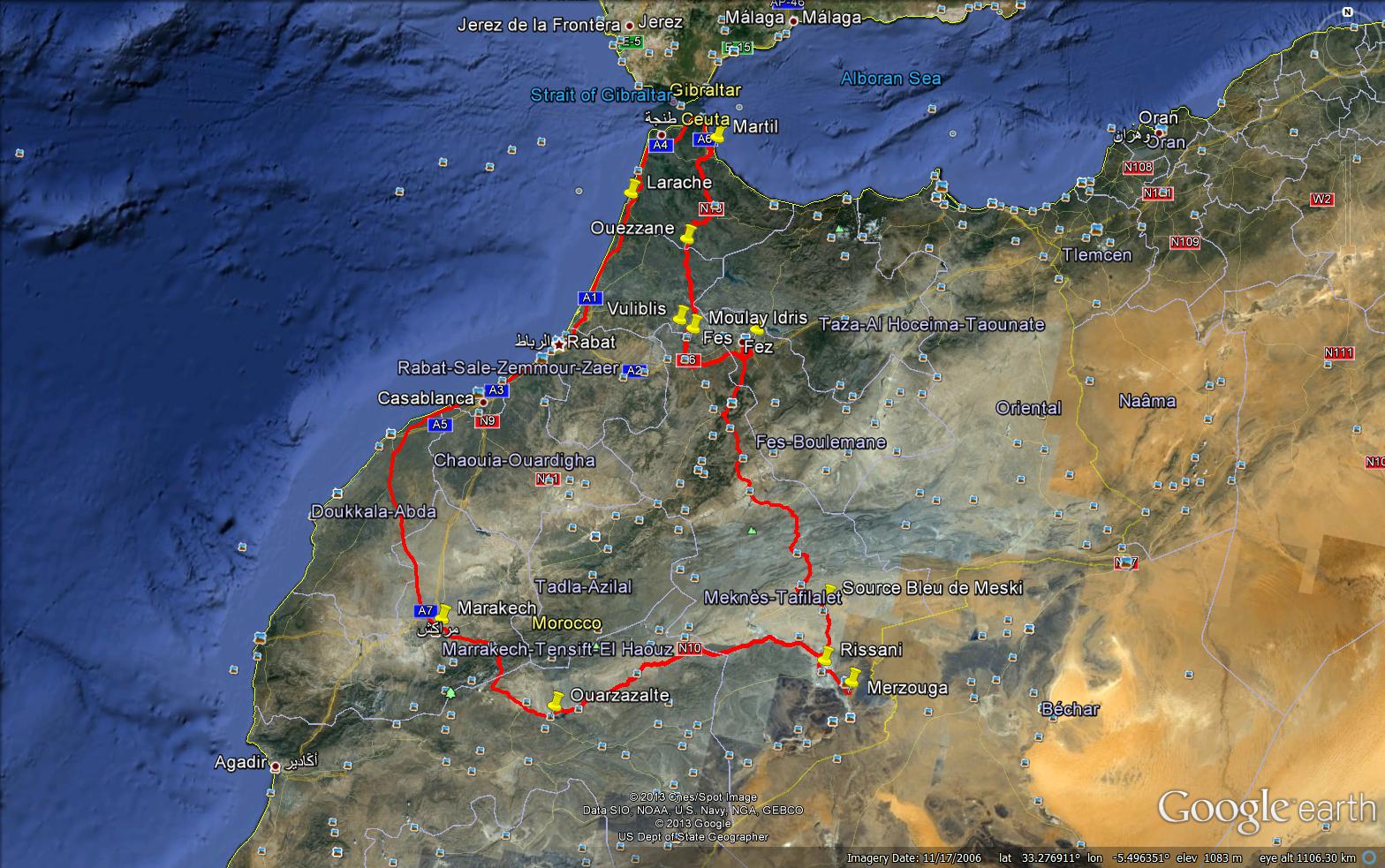I had been thinking about doing a trip to Morocco for some time and had read several blogs written by fellow camper van owners, some loved it while others loathed it and we are getting near to that time in life when it was now or never. There seems to be two types of owners that do this trip – those that travel on their own and those that either form a group or more often sign up with a group specialising in touring Morocco. We didn’t want to sign up with an organised tour as we wanted the flexibility to leave when we wanted or stay longer if we liked it. In addition we felt that some of the organised tours were very expensive for what they offered, given that whichever tour you went with you still had all your fuel and ferry costs getting to Southern Spain to start with. We have been travelling around for over 40 years with caravans and motorhomes and in all that time we had never considered travelling with a group so this was a first for us.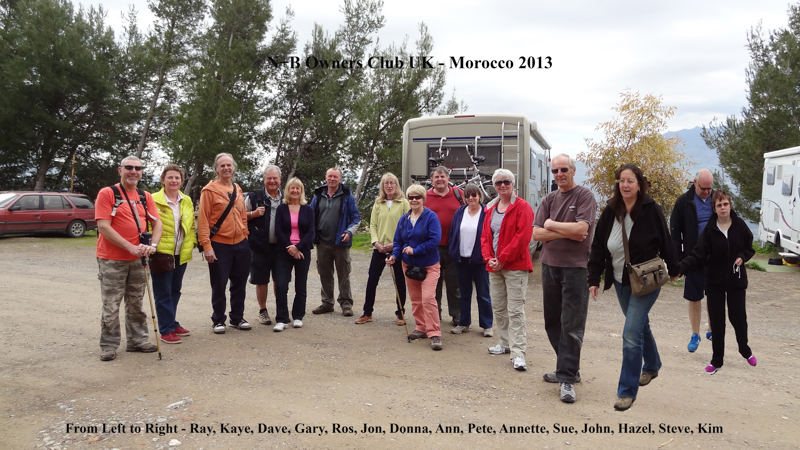
Out of the blue earlier last year one of the N & B owners club members asked on the forum – would anyone be interested in forming a group to tour around Morocco so we said we were interested and signed up as that looked to be our ideal answer. The whole trip appeared to be flexible with members able to join or leave the group as they wished. This was great for us and as the months went by it appealed more and more. The organiser, Ray and his wife Ann had toured Morocco some years earlier and were able to offer advice and point out the pitfalls etc. He also mentioned that we would most likely be stopping on many of the same sites as the organised tour companies yet in our case we paid for everything on a daily basis.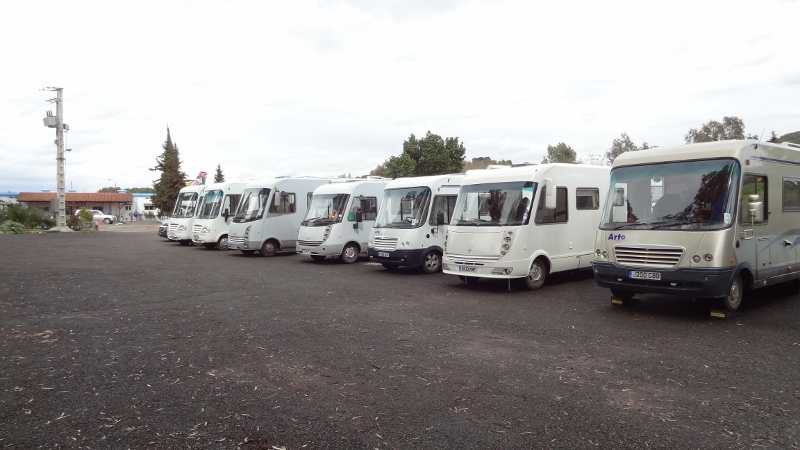
We had only met one couple of the club members so with lots of uncertainty and lots of unanswered questions we set off on Saturday 23rd February and drove down to Portsmouth, parking on the sea front on a very cold dismal day.
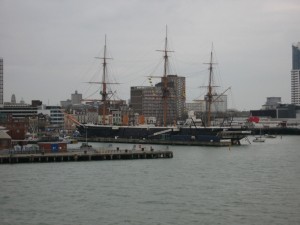 This crossing was also a first for us as originally we had planned to travel down through France, calling at Carcassonne to see the family before meeting up with our group in Tarifa in Southern Spain however our family asked if we could call in Carcassonne on our return as they had planned a skiing holiday that clashed with the dates so after a little thought we decided to try the Portsmouth Santander crossing as it would save some three days driving and allow us more time to prepare for the trip at home. The UK – Spain crossing is now becoming more competitive as the price of fuel rises for those intending to travel to Spain or the south of France.
This crossing was also a first for us as originally we had planned to travel down through France, calling at Carcassonne to see the family before meeting up with our group in Tarifa in Southern Spain however our family asked if we could call in Carcassonne on our return as they had planned a skiing holiday that clashed with the dates so after a little thought we decided to try the Portsmouth Santander crossing as it would save some three days driving and allow us more time to prepare for the trip at home. The UK – Spain crossing is now becoming more competitive as the price of fuel rises for those intending to travel to Spain or the south of France.
We had a leg stretch and wandered around Portsmouth before moving onto the ferry terminal around 10pm and meeting up with some of our group who were taking the same crossing.. We spent the night on the terminal car park finally boarding the ferry around 9:30 am for a 10:30 departure on the Sunday morning. Once on board we were invited into Steve, Hazel and Kims cabin at noon for drinks and nibbles and to meet up with other members of the group travelling with us to Morocco. We had a good smooth crossing to Santander arriving around 11am the following day, disembarking at 12 noon. We set off south on the motorway however it wasn’t long before we hit snow and a partly closed motorway. After a short delay we selected our diff lock and crawled along past several vehicles stuck in the snow and continued our journey finally stopping at Pajares for the night.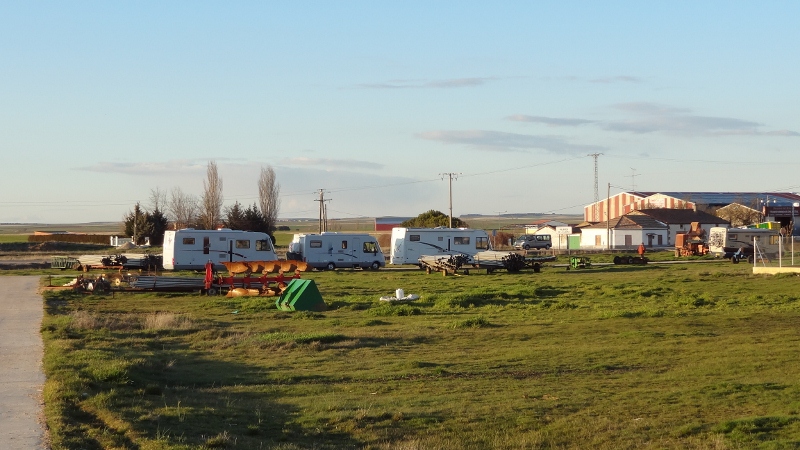
The next morning we woke up to a hard frost and set off once again through some wonderful countryside down the centre of Spain for our next stop just south of Seville at Dos Hermanas on the Camping Viltsom. Some of our group went out for a meal while we finished off our chicken pie. It has become a ritual for us to stock up with easily prepared meals to cover the first few days of any holiday and so we missed out on enjoying a couple of meals out and stuck to our plan and not waste food. The next day saw us down on the Spanish South coast by lunchtime pulling into the campsite called Rio Jara just a few miles outside Tarifa. The last few miles we experienced very windy, cloudy conditions but had a great view across the straights of Gibraltar to see the mountains of Morocco for the first time. 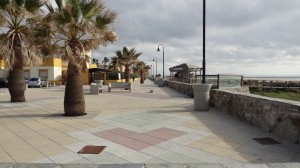 After lunch we decided to walk into Tarifa to get some fresh air – A very pleasant 8kms round trip.
After lunch we decided to walk into Tarifa to get some fresh air – A very pleasant 8kms round trip.
The next morning after a leisurely start we all headed into Tarifa to buy our ferry tickets so that we could cross over on the first of March. We had intended to cross from Algeceras to Ceuta but one of our group discovered that if we went to Tanger Med then the crossing price would be approximately €90 cheaper so we all agreed that was a better deal. We stayed in Tarifa in the afternoon as it was the festival of Andalucia. From Tarifa we headed off to spend the night in the carpark of Lidls in Algeceras so we could stock up with fresh food and drink to cover our first few days in Morocco. 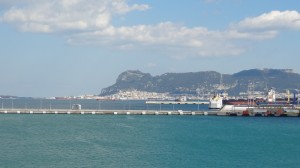 After a very frustrating time at the ferry terminal where the ferry was delayed by some 3 hours, we set off for the relatively short crossing followed by more hassle with the Moroccan police and customs though not as bad as we had been led to believe and far quicker than many of our fellow campers had experienced – all completed in less than 30 minutes. The Algeciras to Tanger Med crossing does not suffer from the numerous “unofficial guides” that, for a small fee, will assist you in getting through the customs and police formalities. Unhindered, we disembarked and went to the customs booth. They asked us to take our passports and paperwork to the police booth, who duly stamped the forms after entering the details in their computer. We then went back to the customs booth who stamped our passports and then we were free to go. Simple as that. The one fly in the ointment is that there is a walk of several hundred yards between the customs and police booths and that was what took the time. On leaving the port we had really good views looking back north across the straights and the Moroccan coastline was spectacular. By then it was getting dark and we finally arrived at the camp site in Martil in the dark and had to spend the night on the campsite road as it was too dark to manoeuvre around low branches from the trees and here we spent our first night in Morocco.
After a very frustrating time at the ferry terminal where the ferry was delayed by some 3 hours, we set off for the relatively short crossing followed by more hassle with the Moroccan police and customs though not as bad as we had been led to believe and far quicker than many of our fellow campers had experienced – all completed in less than 30 minutes. The Algeciras to Tanger Med crossing does not suffer from the numerous “unofficial guides” that, for a small fee, will assist you in getting through the customs and police formalities. Unhindered, we disembarked and went to the customs booth. They asked us to take our passports and paperwork to the police booth, who duly stamped the forms after entering the details in their computer. We then went back to the customs booth who stamped our passports and then we were free to go. Simple as that. The one fly in the ointment is that there is a walk of several hundred yards between the customs and police booths and that was what took the time. On leaving the port we had really good views looking back north across the straights and the Moroccan coastline was spectacular. By then it was getting dark and we finally arrived at the camp site in Martil in the dark and had to spend the night on the campsite road as it was too dark to manoeuvre around low branches from the trees and here we spent our first night in Morocco.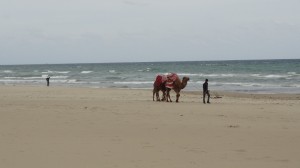 The next morning we went for a walk along the promenade that could have been anywhere in Europe, cloudy, windy but a little warmer than Spain. We turned off the main drag and entered into the Saturday market – wow that could never be described as European. The stalls were makeshift but the goods were varied and numerous. You could have bought anything from live chickens to brass trinkets. We resisted the temptation to buy anything as we wanted to get a feel of things, in particular the way the locals bartered for everything. After lunch we all decided to move on to Chefchouen where we intended to stay for a few days, after all you can do “cold and windy” anywhere and we wanted warmer weather..
The next morning we went for a walk along the promenade that could have been anywhere in Europe, cloudy, windy but a little warmer than Spain. We turned off the main drag and entered into the Saturday market – wow that could never be described as European. The stalls were makeshift but the goods were varied and numerous. You could have bought anything from live chickens to brass trinkets. We resisted the temptation to buy anything as we wanted to get a feel of things, in particular the way the locals bartered for everything. After lunch we all decided to move on to Chefchouen where we intended to stay for a few days, after all you can do “cold and windy” anywhere and we wanted warmer weather..
The drive to Chefchouen was along roads that can only be described as poor to very poor however the scenery was very good. 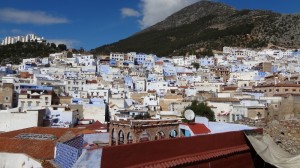 It became an established pattern over the next 1200 miles. In the towns the road surfaces were terrible but got better when away from civilisation, changing again between regions or as we would say counties. The landscape also changed dramatically the further south we went. The campsite at Chefchouen was reasonable and high above the town. It had a restaurant, small shop and laundrette (read woman washing clothes in a river) albeit a bit rough and ready.
It became an established pattern over the next 1200 miles. In the towns the road surfaces were terrible but got better when away from civilisation, changing again between regions or as we would say counties. The landscape also changed dramatically the further south we went. The campsite at Chefchouen was reasonable and high above the town. It had a restaurant, small shop and laundrette (read woman washing clothes in a river) albeit a bit rough and ready. 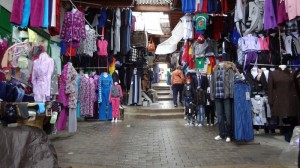 The town itself was very good and by Moroccan village standards quite clean. It is known as the “blue town” as many of the houses are painted light blue. The locals have not yet been spoilt by tourists so they remain friendly and will take a polite no as meaning no. We were however woken up at 5am for the call to prayer. By Monday morning we all decided that we had “done” Chefchouen – again mainly because the weather was misty, drizzly and cold and there was a definite call for warmer weather. We went on south to a site some five kilometres south of Ouazzane and again while not that far it took a lot longer than expected due to the poor roads.
The town itself was very good and by Moroccan village standards quite clean. It is known as the “blue town” as many of the houses are painted light blue. The locals have not yet been spoilt by tourists so they remain friendly and will take a polite no as meaning no. We were however woken up at 5am for the call to prayer. By Monday morning we all decided that we had “done” Chefchouen – again mainly because the weather was misty, drizzly and cold and there was a definite call for warmer weather. We went on south to a site some five kilometres south of Ouazzane and again while not that far it took a lot longer than expected due to the poor roads.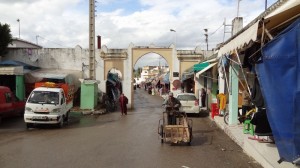 Our site was at a Motel and it turned out to be a very clean and tidy site that would not have been out of place in any French town. We took a “communal taxi” into town – these are free vans with benches down each side and the driver stops to pick up or drop off anyone on his route and the passenger gives a small amount to the driver although it is not compulsory. The town itself was not inspiring however it was the scene of our first Moroccan mint tea. We decided to eat out as a group in the Motel Rif restaurant and had a good three course meal for little more than five pounds a head – we took or own drink of course as the muslim faith forbids the drinking of alcohol though it is not forbidden by law in Morocco. It was disappointing to discover that the restaurant owner hid all the menus with prices on at the request of the tour operators so that “members of official tours” could not see how inexpensive the food was. Over the next three weeks we discovered this to be standard practice on sites where tour companies visited.
Our site was at a Motel and it turned out to be a very clean and tidy site that would not have been out of place in any French town. We took a “communal taxi” into town – these are free vans with benches down each side and the driver stops to pick up or drop off anyone on his route and the passenger gives a small amount to the driver although it is not compulsory. The town itself was not inspiring however it was the scene of our first Moroccan mint tea. We decided to eat out as a group in the Motel Rif restaurant and had a good three course meal for little more than five pounds a head – we took or own drink of course as the muslim faith forbids the drinking of alcohol though it is not forbidden by law in Morocco. It was disappointing to discover that the restaurant owner hid all the menus with prices on at the request of the tour operators so that “members of official tours” could not see how inexpensive the food was. Over the next three weeks we discovered this to be standard practice on sites where tour companies visited.
The following morning we again awoke to rain and were not surprised by the unanimous decision to leave by 9am after having been given free Moroccan bread. We soon cleared the Rif mountains and travelled on the flatlands some of which were cultivated with the main crop appearing to be broad beans and prickly pear. 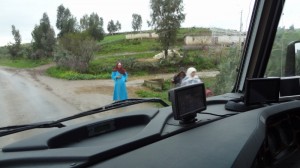 Even in the middle of nowhere there always appeared to be people standing around doing nothing but always waved frantically and smiled while herding one or two sheep or goats. The goat herders showed no respect for roads and often the sheep or goats wandered onto the roads, however they moved out of the way once a vehicle approached. More curiously we had become reconciled to the fact that every 30 or 40 miles we would encounter a police road block where you had to stop in the road and only move forward once beckoned by a police officer. To be fair we were always waved through, often with a salute from the policeman, however all the Moroccans were stopped and searched. Throughout our time in Morocco we had to pass through police road checks at least 6 times every day. In the end not knowing why or what they were doing we came to treat it as an assurance that they were keeping any unruly elements at bay. We did hear of some travellers that failed to stop at the required point being fined by the police however none of our group were fined.
Even in the middle of nowhere there always appeared to be people standing around doing nothing but always waved frantically and smiled while herding one or two sheep or goats. The goat herders showed no respect for roads and often the sheep or goats wandered onto the roads, however they moved out of the way once a vehicle approached. More curiously we had become reconciled to the fact that every 30 or 40 miles we would encounter a police road block where you had to stop in the road and only move forward once beckoned by a police officer. To be fair we were always waved through, often with a salute from the policeman, however all the Moroccans were stopped and searched. Throughout our time in Morocco we had to pass through police road checks at least 6 times every day. In the end not knowing why or what they were doing we came to treat it as an assurance that they were keeping any unruly elements at bay. We did hear of some travellers that failed to stop at the required point being fined by the police however none of our group were fined.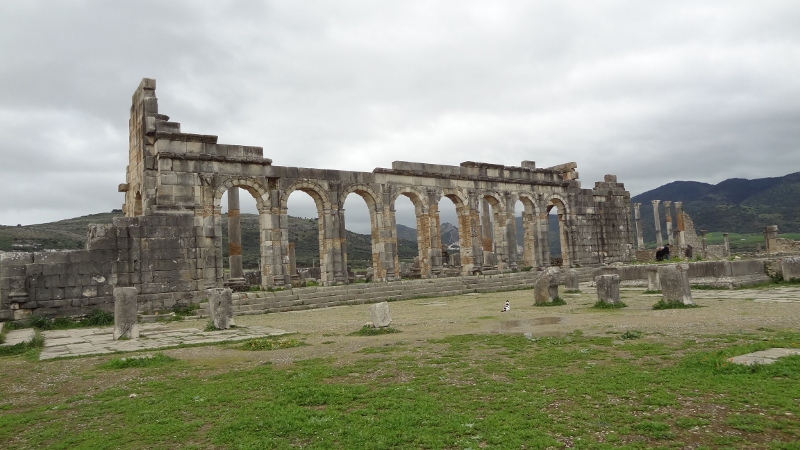
Our lunch stop this day was the Roman remains of Volubilis. These are the most southerly point of any Roman city remains. The ruins certainly gave the impression that the Romans were far ahead of their time and could certainly build things. After spending a couple of hours looking around the remains and dodging the showers we headed off to our next overnight stop – Fes. Unfortunately the weather was still not on our side and the site itself was not only the most expensive we visited in the whole of Morocco but was the dirtiest, had the least facilities of any site we were to use in all our stay. We were not prepared for Fes – we were thrown into the deep end and were battered by offers from unofficial guides whose only objective was to guide us from one “relative to another” all desperately trying to sell us anything and everything they sold. Against all our efforts we were lumbered with a guide and gave in as we were clearly getting know where We finally ditched him after he brought in his friends to guide us also. Clearly we appeared a pushover.
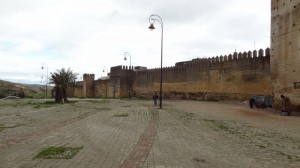 The total cost was some 400 Durhams – about £40 – and we saw nothing of the sights. We were robbed by the taxi driver who didn’t have any change so drove off with our 100 durham note. And it rained on and off all day – even when I BBQ’d that night. I was standing in a lake of water holding a large umbrella. So far we were not impressed by Morocco. I guess it is true what they say – if the weather is good then in general the places you visit are good. Our first week in Morocco had been marred by unusually cool and very wet weather.
The total cost was some 400 Durhams – about £40 – and we saw nothing of the sights. We were robbed by the taxi driver who didn’t have any change so drove off with our 100 durham note. And it rained on and off all day – even when I BBQ’d that night. I was standing in a lake of water holding a large umbrella. So far we were not impressed by Morocco. I guess it is true what they say – if the weather is good then in general the places you visit are good. Our first week in Morocco had been marred by unusually cool and very wet weather.
We cut short our intended stay at Fes as we simply felt cheated by all including the site owner who was only interested in fleecing the tourists and the weather was awful. 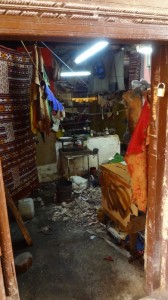 On the good side the street lights were powered by solar panels and the traffic lights had count down clocks. We bought Argon Oil and Saffron so not all was wasted. We set off on the Thursday morning and travelling through some stunning scenery and at long last clear blue skies making for a small town called Midelt. We were now almost one week ahead of schedule.
On the good side the street lights were powered by solar panels and the traffic lights had count down clocks. We bought Argon Oil and Saffron so not all was wasted. We set off on the Thursday morning and travelling through some stunning scenery and at long last clear blue skies making for a small town called Midelt. We were now almost one week ahead of schedule.
Midelt is situated at the start of the Rif valley once you have climbed over the high Atlas mountains. The road rose to over 7600 feet above sea level going over the Col du Ziad and well above the snow line even at this latitude – 32 degrees north. We were surprised to pass several small remote dwellings where tribesmen, Berbers we were told, lived in absolute poverty and isolation. They lived in round tents like Indians from North America that were covered with animal skins with just one or two goats grazing on the very bleak landscape. From here the landscape turned from lush green fields and valleys into brown and yellow flat plains of scrub on rock and sand. The campsite at Midelt was quite well laid out and very tidy with flower beds and individual pitches however the water was turned off so we were unable to get showers, or top up with water. We decided after our BBQ that we would go and explore the town however we discovered that we were locked in the site and unable to leave. The temperature dropped in the evening from a very pleasant 27 centigrade to around 15 as we were still some 5000 feet above sea level. 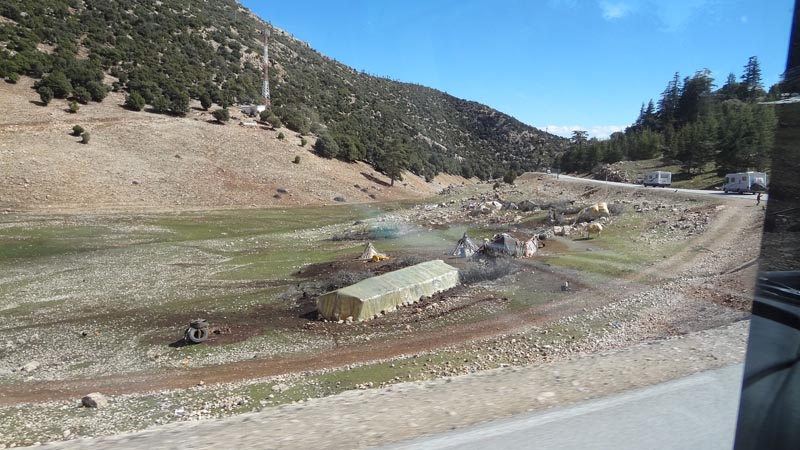
Midelt was only ever an overnight stop so the next day we continued into the Rif valley and gorge. The landscape had changed to a red rock and sand with the river running through the gorge, carved some 100 metres down into the flat plains populated on each side by a 50 metre strip of Palm trees with small areas of cultivated ground at the foot of each tree where vegetables and food for the goats were growing. 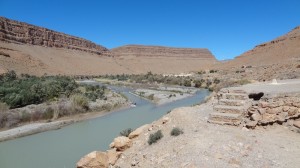 We pulled into a small parking area for coffee by the river where we saw Berber women washing clothes in the river by hand while the menfolk sold trinkets from stalls in the carpark. The temperature was now in the middle 20’s with clear blue skies. Across the river was a Kasbah that looked partially derelict yet had obviously been a grand building in its time. All the buildings were made of mud and straw baked hard by the sun. We were told by various guides that these buildings needed lots of maintenance as when it rained it washed away the mud and the buildings quickly became ruins.
We pulled into a small parking area for coffee by the river where we saw Berber women washing clothes in the river by hand while the menfolk sold trinkets from stalls in the carpark. The temperature was now in the middle 20’s with clear blue skies. Across the river was a Kasbah that looked partially derelict yet had obviously been a grand building in its time. All the buildings were made of mud and straw baked hard by the sun. We were told by various guides that these buildings needed lots of maintenance as when it rained it washed away the mud and the buildings quickly became ruins. 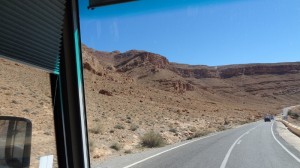 The stories went on that invading enemies would divert the river towards the Kasbah so that it washed away the foundations letting the walls collapse thus allowing the invaders to enter the forts and capture the inhabitants. I can believe this as many of the buildings were in ruins caused by the winter rains. After coffee we moved on to our next stop which was a real Oasis in the desert where we intended to stay a few days..
The stories went on that invading enemies would divert the river towards the Kasbah so that it washed away the foundations letting the walls collapse thus allowing the invaders to enter the forts and capture the inhabitants. I can believe this as many of the buildings were in ruins caused by the winter rains. After coffee we moved on to our next stop which was a real Oasis in the desert where we intended to stay a few days..
We entered our site at Source Bleu de Meski – a very pretty site that was down into the valley floor by the side of the river, completely surrounded by Palm trees and the valley sides. The locals had diverted the river to make a small swimming pool and had dug into the sides of the valley to make shops and a few “offices”. 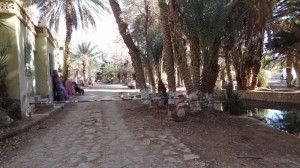 It was an idyllic setting that reminded you of Lawrence of Arabia and books of the Arabian Knights and we certainly could have spent longer here. Unfortunately it was spoilt by the persistent locals who constantly tried to sell you their goods and not taking no for an answer – even after buying goods from them. We went for a walk around the local village and was very surprised to discover that there were no roads or pavements and the houses all faced onto rough mud tracks that were hard baked deep ruts in dry weather but must have been awful in the rainy season as it was clear the tracks would become deep muddy fields.
It was an idyllic setting that reminded you of Lawrence of Arabia and books of the Arabian Knights and we certainly could have spent longer here. Unfortunately it was spoilt by the persistent locals who constantly tried to sell you their goods and not taking no for an answer – even after buying goods from them. We went for a walk around the local village and was very surprised to discover that there were no roads or pavements and the houses all faced onto rough mud tracks that were hard baked deep ruts in dry weather but must have been awful in the rainy season as it was clear the tracks would become deep muddy fields. 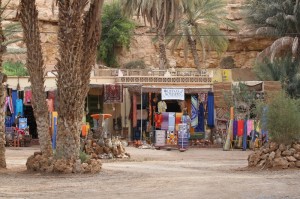 We had a good communal BBQ that evening and the local band came out a played a few traditional Moroccan songs on their drums and guitars. Naturally we were then expected to pay for their services – this time they were after beer and wine – so much for the Muslim teachings. Sadly instead of stopping for a few days we decided to move on the following morning as we had all had enough of the constant pestering that had started to become personal with jibes and comments about it being “their country” and if we wanted to stay then we should buy even more – after several of our group had spent hundreds of pounds of carpets, drums, Jalabas and numerous trinkets.
We had a good communal BBQ that evening and the local band came out a played a few traditional Moroccan songs on their drums and guitars. Naturally we were then expected to pay for their services – this time they were after beer and wine – so much for the Muslim teachings. Sadly instead of stopping for a few days we decided to move on the following morning as we had all had enough of the constant pestering that had started to become personal with jibes and comments about it being “their country” and if we wanted to stay then we should buy even more – after several of our group had spent hundreds of pounds of carpets, drums, Jalabas and numerous trinkets.
From the Oasis we continued down the valley and out into the Sahara desert where the roads deteriorated even further and eventually petered out all together to become desert tracks, taking some 50 minutes to cover the last 6 kms into the Erg Chebbi sand dunes to a place called Merzouga. We spent the next three days here walking in the sand dunes, watching the camel trains and standing on top of the dunes watching spectacular sunsets and visiting the nearby Auberge’s that looked like medieval castles yet were beautiful and cool inside with wonderful wooden furniture and carpets.  We really enjoyed our time in the desert, the sun was hazy for some of the time keeping the temperature down to a bearable 28/29 degrees. We even found time to have a Boules competition and have communal BBQ’s. Camel rides or quad bike hire could be had at one of the local Auberge – this is what Morocco is all about.
We really enjoyed our time in the desert, the sun was hazy for some of the time keeping the temperature down to a bearable 28/29 degrees. We even found time to have a Boules competition and have communal BBQ’s. Camel rides or quad bike hire could be had at one of the local Auberge – this is what Morocco is all about. 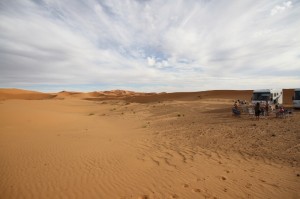 We spent time in the evening star gazing and one or two of our group had brought telescopes to observe the stars. Each evening the stars looked spectacular under the incredibly clear night skies. The eye could pick out thousands more stars than can be seen under the UK skies.
We spent time in the evening star gazing and one or two of our group had brought telescopes to observe the stars. Each evening the stars looked spectacular under the incredibly clear night skies. The eye could pick out thousands more stars than can be seen under the UK skies.
We were joined on the last night by a group of Dutch motor cyclists that were doing the Paris to Dakar rally as part of an adventure holiday. All went well until the following morning when as we were preparing to leave one of the motorcyclists for no apparent reason simply accelerated over one of the sand dunes and slammed into the rear of Steve and Hazels camper van.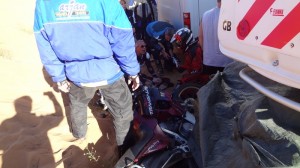 We rushed to check on injuries and found the rider unconscious and lifted the motorbike off the rider. Fortunately the Dutch group had a doctor travelling with them who quickly appeared and took over. We moved the bike out of the way and Steve moved his camper forward to give the doctor more room. We then discovered the rider was a young woman, around 25 years old, and the doctor diagnosed several broken bones including wrist, shoulder and ribs. There was also a worry over her back injuries but the most worrying problem was her difficulty in breathing and suspected internal bleeding.
We rushed to check on injuries and found the rider unconscious and lifted the motorbike off the rider. Fortunately the Dutch group had a doctor travelling with them who quickly appeared and took over. We moved the bike out of the way and Steve moved his camper forward to give the doctor more room. We then discovered the rider was a young woman, around 25 years old, and the doctor diagnosed several broken bones including wrist, shoulder and ribs. There was also a worry over her back injuries but the most worrying problem was her difficulty in breathing and suspected internal bleeding. 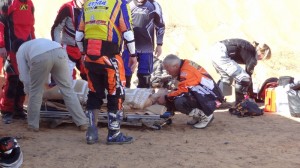 While we all waited for the ambulance to arrive the doctor administered morphine and sedatives to relieve the pain and it took some two hours for the ambulance to arrive and the driver said it was 140 kms to the nearest hospital and the team doctor was so worried that he decided to travel with the woman to the hospital to make sure she made it. In situations like this it brings home the isolation of Morocco and we can only thank our lucky stars that none of our group suffered any mishaps.
While we all waited for the ambulance to arrive the doctor administered morphine and sedatives to relieve the pain and it took some two hours for the ambulance to arrive and the driver said it was 140 kms to the nearest hospital and the team doctor was so worried that he decided to travel with the woman to the hospital to make sure she made it. In situations like this it brings home the isolation of Morocco and we can only thank our lucky stars that none of our group suffered any mishaps.
Once the girl had departed in the ambulance we set out repairing Steve and Hazels camper. Fortunately we were able patch up the camper and it was re-assuring to find that between all the group we carried a good selection of tools, tape, wire and wooden blocks. We set about making temporary repairs to the camper, getting the lights working and making the van safe so that they could continue their holiday. All this resulted in a 12 noon start instead of a 8am start as envisaged and on to our next stop at Tinerhir and the Todra gorge. We later heard from one of the Dutch guys that the girl made it to the hospital and is now on her way to a full recovery. After a very stressful drive over very poor roads and tracks, viewing a sandstorm on our left and very hot weather and stopping for police checks every 30 miles or so we finally arrived at Tinerhir just before dusk. 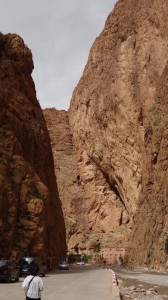 The site was by far the best site we saw in the whole of Morocco. Modeled on the European concept each pitch was individually laid out with water, electric and waste on each one. There were trees surrounding each pitch that gave shade but made it difficult for high vehicles such as the Flair. We spent three days here starting off with a meal at the site restaurant and the now familiar evening get together with the group. It was here that we decided to have our first bicycle ride of the holiday. We decided to cycle into the gorge some 7kms up the valley however I soon discovered that on my bike with hydraulic brakes, both front and rear brakes were not working at all as all the fluid had leaked out from the cylinders. We deduced that driving over the High Atlas mountains had caused the seals to leak, spilling fluid all over the garage floor. It was a careful ride back as it was all downhill. Needless to say there was no where to get the special tool required to bleed the brakes so no brakes for the remainder of the trip. The third day we decided to walk back into the gorge as it was such a lovely place to see, We had the opportunity of stopping for coffee and mint tea at either the Hotel Yasmina in the centre of the gorge or at one of the small cafes found all along the roadside..
The site was by far the best site we saw in the whole of Morocco. Modeled on the European concept each pitch was individually laid out with water, electric and waste on each one. There were trees surrounding each pitch that gave shade but made it difficult for high vehicles such as the Flair. We spent three days here starting off with a meal at the site restaurant and the now familiar evening get together with the group. It was here that we decided to have our first bicycle ride of the holiday. We decided to cycle into the gorge some 7kms up the valley however I soon discovered that on my bike with hydraulic brakes, both front and rear brakes were not working at all as all the fluid had leaked out from the cylinders. We deduced that driving over the High Atlas mountains had caused the seals to leak, spilling fluid all over the garage floor. It was a careful ride back as it was all downhill. Needless to say there was no where to get the special tool required to bleed the brakes so no brakes for the remainder of the trip. The third day we decided to walk back into the gorge as it was such a lovely place to see, We had the opportunity of stopping for coffee and mint tea at either the Hotel Yasmina in the centre of the gorge or at one of the small cafes found all along the roadside..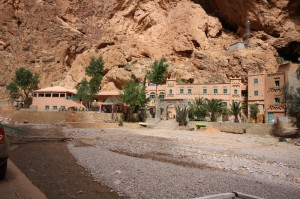
We left Tinerhir to make our way to the head of the Draa valley to the town of Ourazazate and that was to the start of our “problems”. We arrived at Ourazazate around 4pm having stopped at a fuel station to top up the tank just outside the town only to discover an oil leak coming from under the engine, accompanied by a groaning and squeaking from the steering. A quick look around established that there was nothing I could do at the side of the road and as our next stop was only some 2 to 3 miles down the road we decided to get there and investigate. Once at the site I discovered that there was a split in the steering rack gaiter that had allowed sand to enter and ruin the seals causing oil to leak out. Not having any seals or parts for the steering we called out the garage repair mechanic who (against our own diagnosis) declared that the problem was only a split in the gaiter and between stopping for prayers, proceeded to replace it. 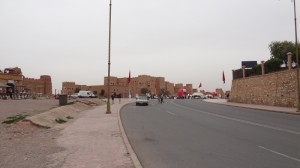 So with not very high hopes that all was well we stayed at Ourazazate for three days and visited the local sights, including the Touarit Kasbah. Reputedly one of a 1000 Kasbahs along the Draa valley. Ourazazate is also famous for its Atlas Film Studio and museum where films such as Cleopatra, Gladiators and Lawrence of Arabia were made. Sadly the place was run down and no films have been made there since before 2009.
So with not very high hopes that all was well we stayed at Ourazazate for three days and visited the local sights, including the Touarit Kasbah. Reputedly one of a 1000 Kasbahs along the Draa valley. Ourazazate is also famous for its Atlas Film Studio and museum where films such as Cleopatra, Gladiators and Lawrence of Arabia were made. Sadly the place was run down and no films have been made there since before 2009.
We left the town on the Monday morning just as the International marathon was starting so had to be diverted around the town and making our way back over the High Atlas mountains towards Marakesh. 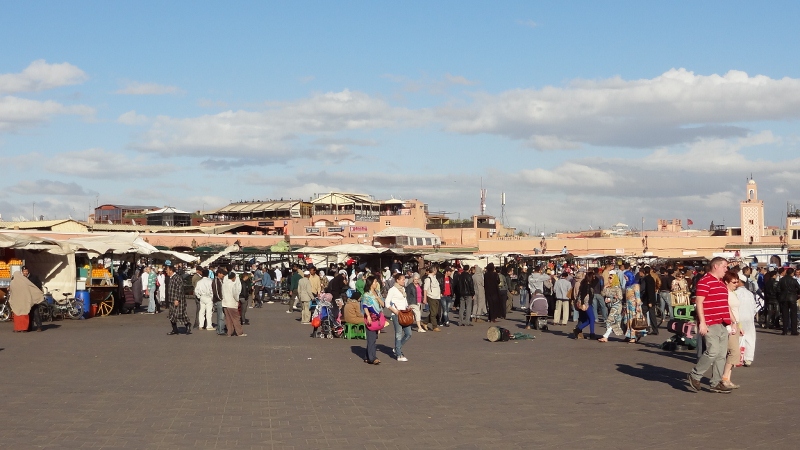 Unfortunately after some 50 miles the power steering packed up again and we had to negotiate hairpin bends, narrow overhanging roads with steep drops on one side and on-coming traffic without power steering. It spoilt what was to have been for me one of the highlights of the trip. With muscles like Popeye we safely reached Marakesh with the help of our colleagues. Here we managed to relate to another mechanic exactly what the problem was and in between prayers he managed to remove the steering rack and took it away to replace the seals.
Unfortunately after some 50 miles the power steering packed up again and we had to negotiate hairpin bends, narrow overhanging roads with steep drops on one side and on-coming traffic without power steering. It spoilt what was to have been for me one of the highlights of the trip. With muscles like Popeye we safely reached Marakesh with the help of our colleagues. Here we managed to relate to another mechanic exactly what the problem was and in between prayers he managed to remove the steering rack and took it away to replace the seals. 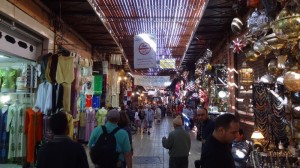 He returned the following day and proudly showed me the damaged seals and proceeded to refit the steering rack. We were able to relax then and enjoy Marakesh as I was reasonably confident that the problem was fixed. We spent the next three days looking around Marakesh, going through the numerous Souks, markets and seeing the sights. We took taxis from the camp site and booked the return before the driver drove off. That way we we didn’t have to worry about finding a taxi for our return to the camper. The Souks in Marakesh are something else. They went on for miles and miles and included all the areas where the trinkets, goods of all sorts and clothes were made. There are only so many items that you can sell and it appeared that Marakesh had them all.
He returned the following day and proudly showed me the damaged seals and proceeded to refit the steering rack. We were able to relax then and enjoy Marakesh as I was reasonably confident that the problem was fixed. We spent the next three days looking around Marakesh, going through the numerous Souks, markets and seeing the sights. We took taxis from the camp site and booked the return before the driver drove off. That way we we didn’t have to worry about finding a taxi for our return to the camper. The Souks in Marakesh are something else. They went on for miles and miles and included all the areas where the trinkets, goods of all sorts and clothes were made. There are only so many items that you can sell and it appeared that Marakesh had them all. 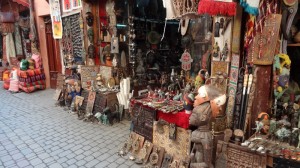 The only problem was that many of the shops all sold the same things. We had decided to hang back from buying trinkets and souvenirs until we had really made up our minds as to what we wanted. Also it gave us an opportunity to see what prices goods really were as none of the shops priced anything. On our last day in Marakesh we went out and bought over 20 souvenirs and presents.
The only problem was that many of the shops all sold the same things. We had decided to hang back from buying trinkets and souvenirs until we had really made up our minds as to what we wanted. Also it gave us an opportunity to see what prices goods really were as none of the shops priced anything. On our last day in Marakesh we went out and bought over 20 souvenirs and presents.
Our enforced change of plans to visit Carcassonne on the way down meant that we were leaving our group at Marakesh as we had now arranged to meet up with the family in Northern Spain for the Easter weekend so after 5 days in Marakesh we set off to spend around six days meandering north towards Barcelona. We had only driven some 50 miles before we realised that the power steering fault had not been fixed and in fact was getting worse. 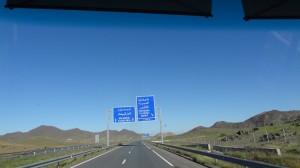 After discussing the problem over a cup of coffee we decided not to spend a couple of nights at L’Arache on the Moroccan coast but to head straight for the ferry and try and get the steering rack replaced in Spain. We were fortunate that another couple in the group, Kaye and Dave also had to return and they followed us all the way to the ferry port to make sure we weren’t stuck. Thanks to both of you. Once in Spain we had breakdown recovery and if all else failed we could get towed back to UK. The road from Marakesh to Tanger Med ferry port is all motorway and driving on the motorway helped us in two ways – the roads were pretty straight so no heaving on the steering wheel and the motorway road surface was reasonable so we didn’t suffer the bone shattering pot holes we had experienced throughout the rest of Morocco. We arrived at the ferry just in time to see the ferry disappear over the horizon so had to wait eight hours for the next ferry to arrive. We finally arrived in Algeciras at 6am in the morning and spent a few hours sleeping in the Lidl car park.
After discussing the problem over a cup of coffee we decided not to spend a couple of nights at L’Arache on the Moroccan coast but to head straight for the ferry and try and get the steering rack replaced in Spain. We were fortunate that another couple in the group, Kaye and Dave also had to return and they followed us all the way to the ferry port to make sure we weren’t stuck. Thanks to both of you. Once in Spain we had breakdown recovery and if all else failed we could get towed back to UK. The road from Marakesh to Tanger Med ferry port is all motorway and driving on the motorway helped us in two ways – the roads were pretty straight so no heaving on the steering wheel and the motorway road surface was reasonable so we didn’t suffer the bone shattering pot holes we had experienced throughout the rest of Morocco. We arrived at the ferry just in time to see the ferry disappear over the horizon so had to wait eight hours for the next ferry to arrive. We finally arrived in Algeciras at 6am in the morning and spent a few hours sleeping in the Lidl car park.
We certainly knew we were back in Europe as it was raining hard, blowing a gale and by Moroccan standards very cold. We spent a hour or so trying to locate an Iveco dealer as we thought Iveco would be the most likely garage to have the parts and be able to fix the camper properly.
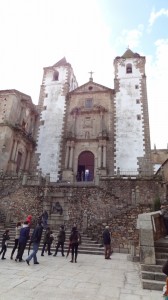
We discovered that the nearest Iveco dealer was in Seville so we set off up the motorway. We called the breakdown insurance company to get the address but they took too long to get back to us and by the time they did we had travelled some 100 miles north of Seville and parked at the camp site in Caceres which just happened to be across the road from an Iveco dealer. Unfortunately it was lunchtime on a Saturday and everything was closing for the weekend so we had to stay there until Monday morning before the dealer could order the parts. On the Monday morning we turned up at the dealer didn’t have the parts in stock as we were right hand drive and they couldn’t decide how many days it would take for the parts to arrive. After much deliberation we decided not to wait in Caceres and instead drive straight for the port at Bilbao and take the ferry back to Portsmouth. We would not have been able to meet up with our family for Easter as their plans had also changed so there was little point in hanging around then travelling to Carcassonne as the kids would be back at school and our son would have been back in England.
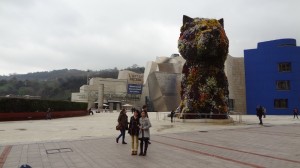
We drove up to Bilbao and spent 2 days parked on the quay waiting for the ferry so spent the time sightseeing the city, visiting the galleries, monuments, including the Guggenheim Museum and old town before boarding the ferry for home finally arriving home on Good Friday. After a shaky start, mainly due to the poor weather and a severe culture shock we did enjoy Morocco and if we were to go back there then there are some places we wouldn’t bother going back to and there are some places we would still like to explore. Sadly it appeared to us that tourists were spoiling Morocco as it isn’t in the Western culture to barter for goods and also Westerners like to browse. In Morocco they don’t do browsing and in their eyes if you ask the price of an item it is because you want to buy it and so it is only a matter of agreeing the price. Westerners we saw tended to walk away if the price was exorbitantly high and this usually offended the trader. On the other hand the canny trader exploits the Western culture by trying it on by asking a price that is way above what he wants just on the chance the Westerner will accept. Sadly for the rest of us many Westerners do accept the price then moan all the way home.
What did we think about travelling in a group? Well for us it worked out fine. We enjoyed the company and there was the feeling of “safety in numbers”. Travelling with like minded camper van owners added that little extra and that we did like. Would we travel with an “official organised tour” – probably not and certainly not to Morocco as it became clear that the organisers of such tours are the main beneficiaries. The tour operators used many of the same camp sites that we did and these sites were similar in price to everyday Aires in France, ranging from £3 to £8 per night. The idea of tour operators having breakdown facilities is also questionable as the local mechanics are much more “adaptable and inventive” and can fix most things. We met up with two of the so called tour operator breakdown vehicles they were more impressive than practical and it appeared that their sole role was to tow you into a garage. We had several meals out in similar restaurants where a three course meal cost not much more than £7 per head. By my reckoning these operators make approximately £2000 per couple profit with the remaining £500 or so being the real cost of the tour.
Finally our thanks must go the Ann and Ray for letting us join their group and the welcome we received from all the group members we met and hopefully we will meet up again soon.
For more photos visit our Gallery. http://www.vennwood.co.uk/?page_id=4153
Trip Statistics:
| Time Away | 37 days | Distance travelled | 3313 miles | |
| Cost of Ferry | £1261.00 | Cost of Fuel | £512.09 | |
| Cost of LPG | £37.86 | Cost of Tolls | £48.92 | |
| Cost of Aires | £202.07 | Repairs to Flair | £1425.50 |
